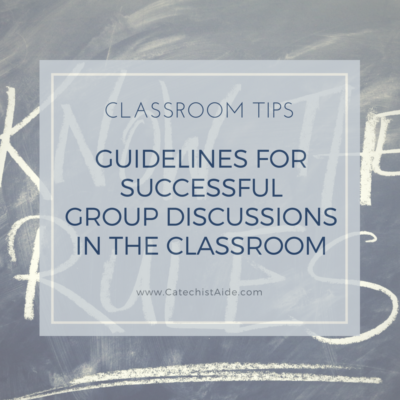
To achieve the benefits outlined last week, we must follow some basic guidelines for successful group discussions in the classroom. Giving students the floor to freely discuss any subject without guidelines or ground rules can quickly lead to chaos. Quality group discussions don’t just happen; they require thoughtful planning and preparation. Here then, are guidelines for successful group discussions to try in your classroom.
Plan Your Outcome
Start your planning with determining what it is that you want the students to take away from the discussion. For example, if your lesson is about the fall of man, then you might wish to focus the discussion on how we can easily succumb to the sin of pride. You might begin with questions that allow students to identify prideful words or actions of historical or celebrity figures. Subsequent questions would switch the focus to potential areas of personal pride. The takeaway lesson might be “It’s easy to see the pride in others but spotting it in ourselves requires self-examination.”
Generate Interest
Introduce the topic via a short video or song, a Bible story or parable, or just a question. This is an opportunity to get the students’ attention and generate interest in the discussion that will follow. In our previous example of a lesson on the fall of man, you might want to begin with a YouTube video of Muhammad Ali’s famous “Rumble in the Jungle” speech. Keep in mind that you would need to set up the video with some context for Generation Z.
Use Handouts
A worksheet gives students an opportunity to quietly read, reflect and answer questions before the discussion begins. Handouts also provide a roadmap for the discussion. Try to incorporate questions that solicit opinions where there is no right or wrong answer. These are usually better suited to getting the conversation started, since no one is worried about answering incorrectly. The purpose of the discussion is to connect the lesson to the students’ everyday life. So, following our previous example, we might begin with questions like, “In the video we just watched, which of the claims made by Muhammad Ali might lead a person to believe he is proud?” Follow up with more thought-provoking questions. You could list examples and ask students to identify whether each represents healthy or excessive pride.
Establish Boundaries
These are deal breakers as far as I’m concerned. The class needs to understand that group discussions will only happen when done so respectfully. Be sure to articulate these rules before beginning the discussion.
- No one will be forced to talk, but all are expected to participate. Some students may not feel comfortable sharing their thoughts, and that’s okay. However, everyone in the group is expected to complete the handout, and if they’re not sharing, they need to be listening.
- No judgment zone. We are here to discuss and gain insight, not to put each other down or call people out. We don’t have to agree with one another about everything, but personal attacks or jabs will not be tolerated.
- Only one person speaks at a time. This is simple common courtesy. Every person in the group deserves to be heard
- Stay on subject. Discussions can veer off-subject rapidly. This can be a distraction, in which case you want to shut down the discussion and steer it back to the subject at hand. Then again, if this is something the students are genuinely concerned about, it may warrant further or future discussion.
- Questions are always welcome. Assuming that time permits, you can encourage students to ask questions, as this promotes further dialogue.
Incorporate Scripture
As Catechists, we should refer to Scripture whenever possible. In our example of a discussion about the sin of pride, you might ask the students to read the Magnificat (Luke 1: 46-55). Mary is the model of humility. Even after learning that she was to be the mother of our Savior, she remained a humble servant. Ask the students to point to specific instances in the passage where the Blessed Mother expresses her humility. Including Scripture helps to reinforce that students should look to Scripture for answers to questions they have.
Group Size
One final, but important, consideration – your class size. If you class is large, consider breaking into smaller groups, so that every student can share in the discussion. You can ask adult volunteers to pitch in as group leaders. This is a great way to get parents or your parish Youth Minister involved.
With proper planning, your group discussions will get your students thinking and talking about their faith life.
© 2018 Catechist’s Aide
Leave a Reply